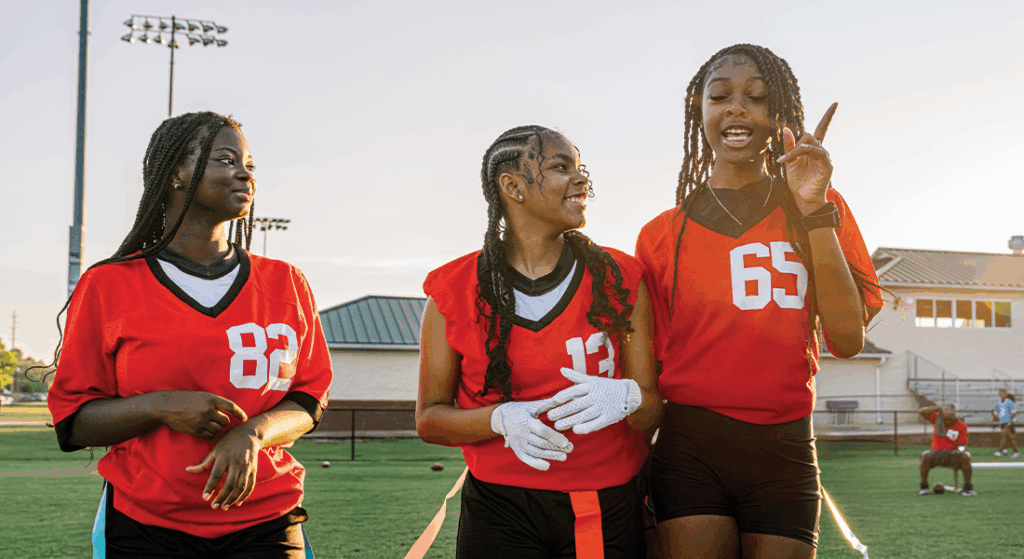“Could my kid be the bully?” Four Steps to Changing the Cultural Narrative Around Bullying
Prevention Education Series
The goal of this series is to bridge the gap between prevention education theory with on-the-ground practice.

Take a second and reflect on articles you’ve read about preventing bullying, or newsletters sent home from school about bullying prevention efforts. Chances are that the focus in most of those resources was on what parents, guardians, teachers, coaches, and other adults can do to protect those being targeted. But preventing bullying from happening means confronting why it’s happening at all. It’s often bullied kids who become someone else’s bully, so how do we prevent kids from bullying in the first place?
As the mom of two kids who have experienced chronic bullying, I can share that most of the resources I have received focus on the experiences of victims. Which, in some ways, makes sense. After all, we know this type of trauma can impact brain development and lead to negative physical and mental health outcomes that can last into adulthood. It makes sense that we do all we can to protect these kids.
And while I certainly want my own kids to be protected, I can’t help but wonder what messages and resources the other parent is receiving? What might happen if we expanded our efforts beyond simply supporting those who are experiencing harm? If we want true culture change (for everyone involved), we need a reframe that addresses the fact that both children—the one bullying and the one being bullied—need intervention from the adults around them. In short, by only focusing on the targets of bullying, we are missing an opportunity to intervene before bullying happens.
For this reason, we need to broaden the conversation in sport to not only include identifying when our kids are hurt—but also when they might be hurting others. Let’s explore another perspective about why kids choose to bully, how to reframe this behavior as kids seeking connection, and how to safely, intentionally invest in these kids while also maintaining prevention policies before bullying happens in the first place.
Step 1:
Examining Our Assumptions about Bullies
In pop culture, bullies are the mean kid, the snarky popular kid, or the kid who plays malicious pranks. They are usually one-dimensional characters with little nuance or complexity. We know what bullies do, but we rarely learn the why behind their behavior. They simply exist as an example of what not to be. Nobody watches Sid in Toy Story and thinks, “I hope my child grows up like that!”
In reality, we know that there are reasons (not excuses, but reasons) behind bullying. Sometimes, bullying is about a child’s insecurity and their inability to process that pain. Sometimes, it’s a prevention strategy for a child who has been bullied before. For example, if an athlete was bullied on last year’s football team, they might make the decision to play the role of bully (or to align with another player who is bullying others) next season to avoid being targeted again.
Some kids have never learned how to control their emotions or have never been taught how to handle conflict in a healthy way. Other kids bully because they are experiencing trauma at home, such as abuse, death, or an illness in the family. Essentially, they have feelings bigger than their coping mechanisms.
None of this context excuses the behavior. And to be honest, it’s been really difficult for me to try to understand the kids who have sent my own small humans home crying. But, as an anti-violence educator, I inherently know that if we want to change behavior, we must get at the root of why it’s happening.
So, step one is for all of us to examine who or what we picture in our minds when we think of a “bully.” Especially in sport. We won’t feel compelled to connect with an athlete who might be on the path to bullying if we don’t first interrupt our own internalized cultural narrative around bullies.
Step 2:
Recognizing How Sport Culture Is a Perfect Environment for Bullying
Participating in sport can lead to positive character development. Competition, peer influence, and the pressure to improve all help athletes learn and grow. But these are the same cultural dynamics that can breed bullying.
There is a fine line between peer influence and peer pressure; between gaining responsibility and taking advantage of unfair power dynamics; between playful team bonding and teasing; and between peer feedback and targeted criticism. Common elements of sport culture can cross quickly into harmful behavior.
Bullying behaviors may show up as:
- Teasing or excluding teammates
- Repeated intentional targeting of weaker players during drills
- Publicly humiliating teammates (locker-room jokes, hazing)
- Masking physical intimidation as just “playing hard” in some sports
These behaviors can escalate if unrecognized. I believe most parents and coaches understand how important it is to invest time and energy into caring for kids who are bullied, boosting their self-esteem, and helping them feel like they belong. But many caring adults also struggle with identifying the early warning signs that that same child might be on the path to bullying. And we lack structure on how to collectively and proactively address the warning signs that precede aggressive behavior, especially in sport.
Step 3:
Learning the Warning Signs
The third step is to think about our spheres of influence (as parents, guardians, coaches, and mentors) and learn the warning signs that kids in our care could be on a path to bullying.
Ask yourself:
- Have they been bullied in the past?
- Are they feeling more self-conscious lately due to changes in their bodies or hormones?
- Are they navigating any difficult life transitions like divorce, death, etc.?
If we can answer “yes” or “I don’t know” to any of the above, then it’s important to be knowledgeable about specific warning signs.
Behaviors to be aware of include:
- Increased complaints about conflict with peers
- Dismissing or mocking others who make mistakes (in TV or movies and in real life)
- Sudden increase in secrecy about social dynamics with peers
- Noticed increase in “bossiness” or aggressive sarcasm outside of sports
These are not signs of a “bad kid.” These are signals that a child might have unmet needs that could lead to bullying. Bullying often masks pain. And while this isn’t an excuse, it is an important clue.
Step 4:
Recognizing How Sport Culture Is a Perfect Environment to STOP Bullying
In sport, character building is not simply a byproduct. It’s a fundamental component of sport culture, particularly in youth sport. This makes sport a perfect environment for directly intervening early in the behaviors of an athlete who is struggling.
We already have formal and informal mechanisms for conversations with athletes about their character and about the type of person they want to be both in and outside of sport. If we expand our scope a bit and ensure we are primed to spot the unmet needs of an athlete that could lead to bullying, we have a greater chance of intervening before harm is caused.
- Talk to your kids and players about why kids might bully. Helping them see bullying as one of many coping mechanisms can help them identify better alternatives.
- Address any root causes. For example, a child acting out in sport because of problems at home may benefit from talking to a mental health professional. Be prepared to make referrals if kids share they are struggling.
- Model empathy and share your own experiences with bullying. Talk about a time when you felt the pain of bullying. Even more powerful, talk about a time when you said or did something that hurt another person. Be vulnerable about the lessons you learned the hard way about why it’s not ok to bully.
- Cultivate a relationship with your child’s coach and seek to understand what appropriate physical play looks like in their sport.
- Provide mentoring and support while following prevention policies. The Center’s Minor Athlete Abuse Prevention Policies (MAAPP) set standards for practices that help prevent abuse and misconduct like bullying. For example, the MAAPP establishes rules about monitoring locker rooms where bullying may be more likely to occur.
Shaping A New Narrative
Shifting culture isn’t about ignoring or making excuses for bad behavior. On the contrary, what I am suggesting is that we start identifying very early warning signs in kids who might need better ways to manage their emotions. Shaping a new narrative means reframing our approach to kids who bully not as villains but as kids in distress. All athletes who bully need adult intervention. Further, while it might feel more natural for me to picture my own kid as the target of bullying, the truth is that (without intervention) bullied kids can often become someone else’s bully.
So, I invite us to train ourselves to watch out for and be invested in the growth and development of all kids, even (and perhaps especially) those who need healthier coping mechanisms. This doesn’t mean we’re excusing bullying behavior. It means we’re prioritizing the health and well-being of every athlete. When we’re united in stopping bullying, we help create the next generation of leaders that will do the same.

Monica Rivera
Vice President, Education & Research, U.S. Center for SafeSport
Monica has spent nearly two decades in the field of interpersonal violence prevention, much of that time working directly with survivors of abuse. She leads our team of subject matter experts who share a belief in the transformative power of prevention education.
Do you have any questions or ideas? Please reach out to [email protected].
Featured Resource
Coaches of Minor Athletes play an important role in creating safe and inclusive sport environments. Share this handbook with them so they can practice strategies for preventing and responding to bullying on their teams.
JOIN OUR EMAIL LIST
Stay connected with the latest news, resources, and tools. Enjoy our quarterly e-newsletter, The Gameplan.
